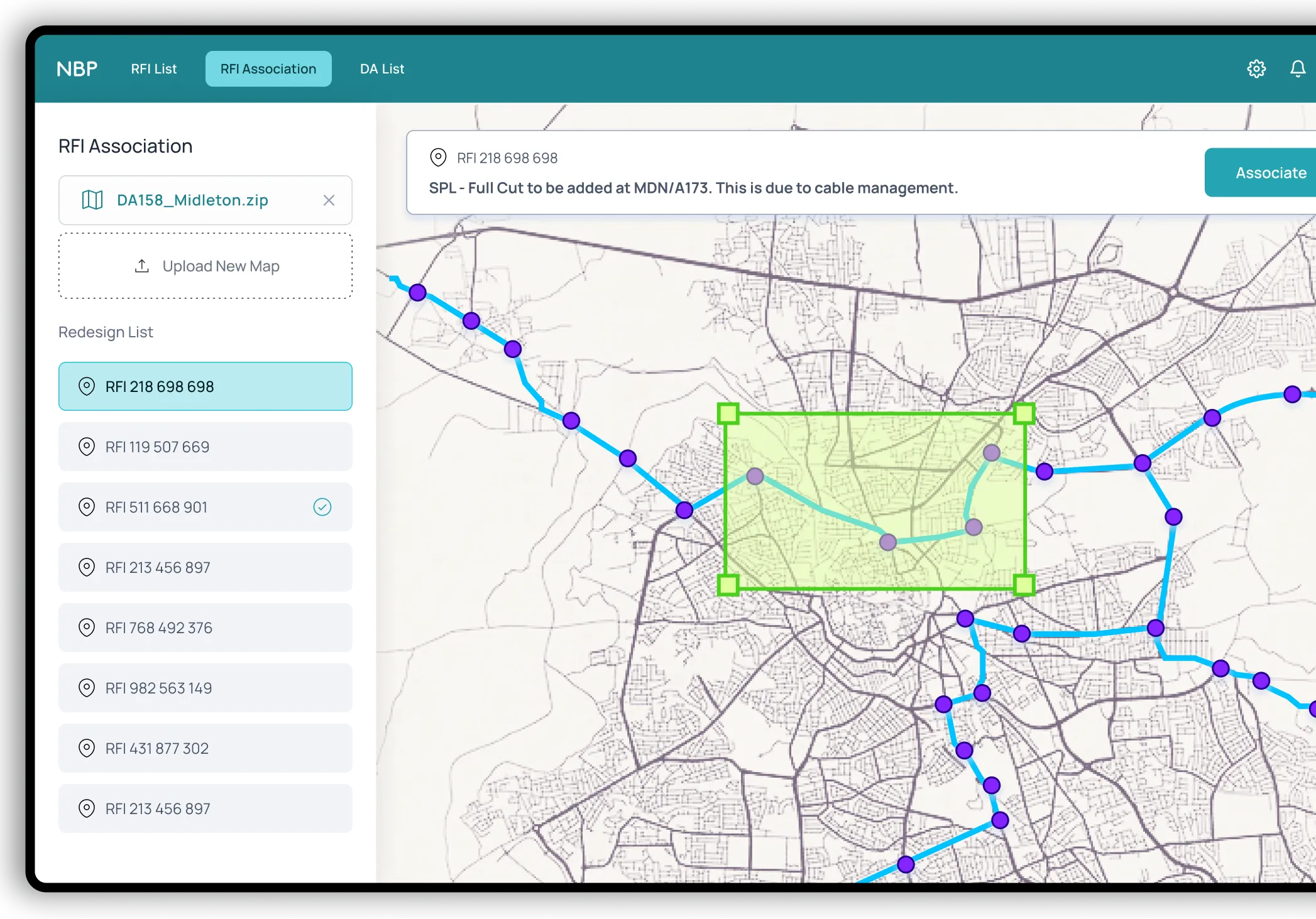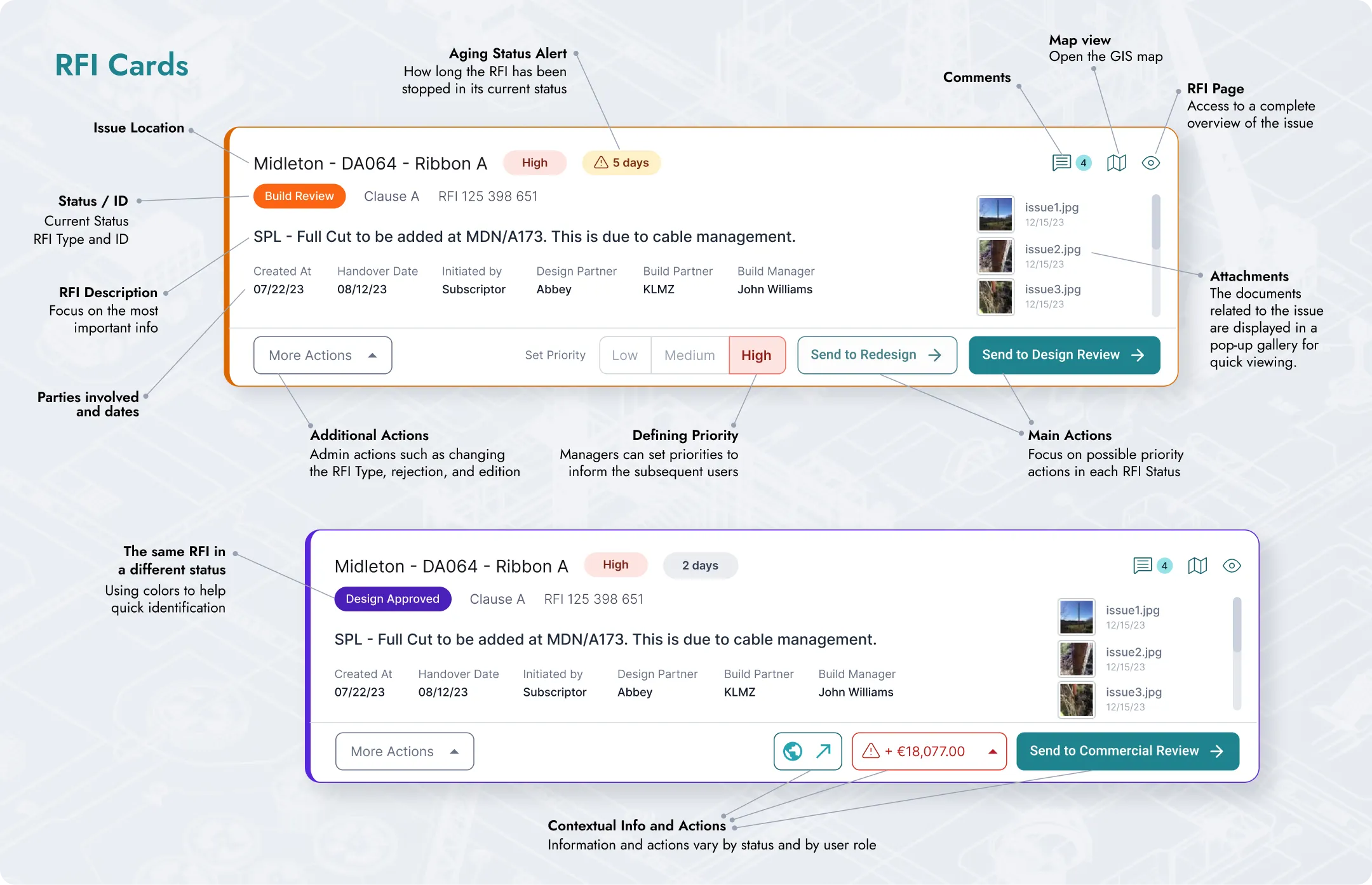LEAD UX UI DESIGNER – 2022 / 2023
Ireland’s National Broadband Plan
The National Broadband Plan is the largest telecom project in the history of Ireland. To provide nationwide internet coverage, €5.5 billion is being invested to construct broadband network infrastructure covering 96% of the country.

PROJECT SUMMARY
The client needed a centralized management solution to handle and reduce resolution time to 300,000 construction issues.
MY ROLE
I worked as the sole UX/UI designer in a team with five developers and collaborated with the client’s product manager and two product owners for two years.
Simplifying Management in Large-Scale Construction
Navigating the Sea of Users and Stakeholders
The project required the cooperation of numerous teams with thousands of workers together in the country, including Build Managers, Design Teams, Business, Financial, and Commercial Teams on the client side, and third-party Design and Build Partners working as contractors. This diversity introduced a complex web of communication and process needs, which had to be managed effectively to ensure the success of the project.
The RFI: A Critical Bottleneck in Construction Management
The Requests for Information (RFIs) are on-site problems reported by the Build Contractors and played a vital role in the project’s challenges. Each RFI has different impacts on construction and its costs and needs to go through specific workflows for the assessment and actions of various users.
This process needs the analysis of several pieces of info and files to complete each task, generating thousands of data points, including emails, spreadsheets, documents, GIS maps, and analytical charts. This variety of tools makes the process complex, potentially prolonging the time required to resolve issues and increasing the likelihood of errors.

Our goal was to improve the workflow, strengthen communication and transparency, and effectively shorten the resolution time for RFIs.
Insights from Discovery
To prepare for the project and the interviews, I studied its key aspects, focusing on the construction phase involving the installation of fiber-optic cables and essential infrastructure, while considering technical, environmental, and regulatory standards. I also familiarized myself with the roles of Build Managers overseeing the project’s progress, the Design Team planning the network and deciding on infrastructure placement, and the Financial Team managing the budget and material costs.
Exploring Opportunities for Enhancement in the RFI Process
I discovered opportunities to refine the workflow by examining the client’s RFI documentation.
While robust for straightforward cases, the current system could benefit from added flexibility to smoothly address diverse scenarios, including unexpected moments requiring adjustments in the RFI’s course.
Stakeholder Interviews: A Crucial Step with Limitations in a Large-Scale Project
I conducted several valuable interviews; however, because of the large number of decision-makers in different areas with tight schedules, you can’t get them all on the table and approve the ideas within the tight project deadlines.
This realization led me to look for a more effective way to engage with the numerous stakeholders of the project.
The RFI Journey: Mapping the Process to Better Reach Decision-Makers Quickly
I started mapping each process piece and emailing them with questions and suggestions to the teams involved.
The diversity of challenges, from issue variability to multiple outcomes, necessitated a clear visual strategy.
This approach helped in both:
- Clarify the intricacies of the RFI Journey.
- Reach the decision-makers faster for approvals
The client received this approach well and used those mappings in their meetings to reevaluate the process and visualize improvement opportunities.
I was able to get faster responses, which led me to maintain a prototyping speed consistent with the project’s deadline expectations.

Prototyping and Bridging the Gap of Design and Development
Due to high expectations and tight deadlines, the project demanded speedy work without compromising quality. I closely collaborated with five developers in one-week SCRUM sprints, requiring a quick approach to prototype and validate the designs with our team, the client’s team members, and final users.
Validating ideas with interactive Figma prototypes
I worked quickly to create high-fidelity mockups for validation with the team and users, as well as new components for the design system.
Helping fine-tune React code and Material-UI components
I directly engaged with the code to refine and tailor Material-UI (MUI) components, to enhance and match the design style.
Key Features
In addition to managing RFIs, the entire project encompassed dozens of screens, including dashboards, tables, GIS map configurations, and cost calculations for outsourced materials and labor. Here are some highlights:
Accelerating Decision Time with RFI Cards
Build Contractors used to submit RFIs through an ArcGIS table, attaching necessary documents and photos. This method, however, made reviewing RFIs cumbersome due to the extensive data scattered across numerous rows and columns. The challenge of efficiently locating and assessing specific RFIs underscored the demand for a more straightforward, more direct approach.

Optimizing for Speed in Decision-Making
What is the minimum information needed to take action?
To facilitate quick decision-making, I have concentrated on organizing the information required for prompt action in a manner that benefits the users. Below, you will find examples of how the card appears in two of its various statuses:

The RFI List page presents incoming issues in cards, streamlining the filtering process. Users can make quick, informed decisions, improving workflow productivity by focusing on data and straightforward actions.

On the RFI page, the users can access more information, such as a log of the RFI statuses and a Cover Sheet, a detailed document about the issue and its redesign.



Enhanced RFI Management: Integrating Redesigns and Cost Calculations
We simplified redesign submissions by allowing Design Partners to link their GIS tool redesigns directly to RFIs in our hub. This integration enabled the automatic recalculation of construction costs upon redesign approval, streamlining the process for both the design and financial teams.

The automatic recalculation and display of the Bill of Quantities (BOQ) and Bill of Materials (BOM) was crucial for the financial team to swiftly evaluate the CAPEX and OPEX. By avoiding multiple spreadsheets, this streamlined approach allowed the team to make informed decisions and quickly approve redesigns.

Conclusion
According to the analysis, we have achieved an efficient gain as the issue resolution time has been reduced by up to 80%, which highlights our team’s success in the project.
During the project, I thrived in a dynamic setting and saw challenges as opportunities for growth. As the lone UX/UI designer, I faced and overcame many hurdles, which deepened my understanding of managing a large-scale project with significant expectations.
Next Project
LEAD UX UI DESIGNER
Map and Code a Business with AI
Dot-Star is a SaaS platform that uses natural language processing to map business processes and automate backend code.
